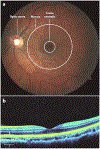The macular carotenoids: A biochemical overview
- PMID: 31931175
- PMCID: PMC7347445
- DOI: 10.1016/j.bbalip.2020.158617
The macular carotenoids: A biochemical overview
Abstract
Among the more than 750 carotenoids identified in nature, only lutein, zeaxanthin, meso-zeaxanthin, and their oxidative metabolites are selectively accumulated in the macula lutea region of the human retina. These retinal carotenoids are collectively referred to as the macular pigment (MP) and are obtained only through dietary sources such as green leafy vegetables and yellow and orange fruits and vegetables. Lutein- and zeaxanthin-specific binding proteins (StARD3 and GSTP1, respectively) mediate the highly selective uptake of MP into the retina. Meso-zeaxanthin is rarely present in the diet, and its unique presence in the human eye results from metabolic conversion from dietary lutein by the RPE65 enzyme. The MP carotenoids filter high-intensity, short-wavelength visible light and are powerful antioxidants in a region vulnerable to light-induced oxidative stress. This review focuses on MP chemistry, absorption, metabolism, transport, and distribution with special emphasis on animal models used for MP study. This article is part of a Special Issue entitled Carotenoids recent advances in cell and molecular biology edited by Johannes von Lintig and Loredana Quadro.
Keywords: Age-related macular degeneration; Carotenoid; Lutein; Macular pigment; Nutrition; Zeaxanthin.
Copyright © 2020 Elsevier B.V. All rights reserved.
Conflict of interest statement
Declaration of competing interest The authors declare that they have no known competing financial interests or personal relationships that could have appeared to influence the work reported in this paper.
Figures








References
-
- Bone RA, Landrum JT, Hime GW, Cains A, Zamor J, Stereochemistry of the human macular carotenoids, Invest. Ophthalmol. Vis. Sci 34 (1993) 2033–2040. - PubMed
-
- Woodall AA, Britton G, Jackson MJ, Carotenoids and protection of phospholipids in solution or in liposomes against oxidation by peroxyl radicals: Relationship between carotenoid structure and protective ability, Biochimica et Biophysica Acta (BBA) - General Subjects. 1336 (1997) 575–586. 10.1016/S0304-4165(97)00007-X. - DOI - PubMed
Publication types
MeSH terms
Substances
Grants and funding
LinkOut - more resources
Full Text Sources
Other Literature Sources
Medical
Research Materials
Miscellaneous

